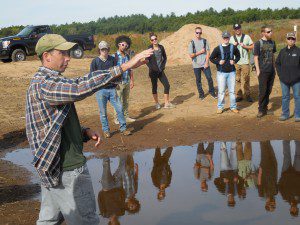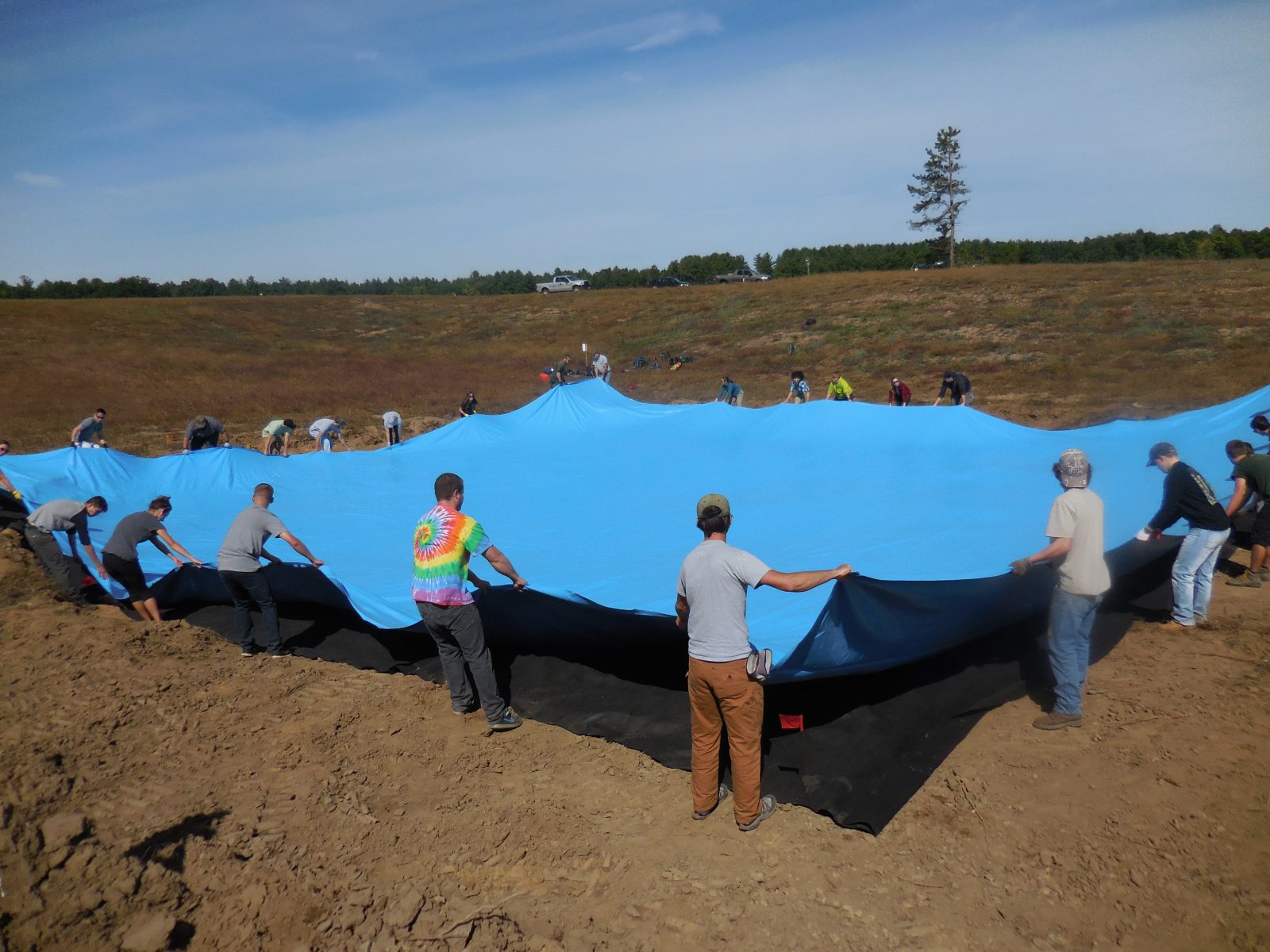
Kubel shows students a vernal pool made out of existing materials two weeks ago that is retaining water. (Photo by Amy Porter)
SOUTHWICK – On Monday, twenty Westfield State University students led by John McDonald, assistant professor of environmental science, traveled to the Southwick Wildlife Management Area to help staff members from the Massachusetts Division of Fisheries and Wildlife (DFW) construct a vernal pool basin to provide critical breeding habitat for the state-threatened Eastern Spadefoot toad species.
Jacob Kubel, a conservation scientist with the DFW’s Natural Heritage and Endangered Species Program, explained that the Eastern Spadefoot is so named due to a hardened appendage in its rear foot that helps it to burrow underground as deep as ten feet. The toads breed in ephemeral vernal pools, which only tend to form in response to heavy rain. A rise in the water table signals them to come to the surface and breed, and lay their eggs.
Kubel said the species is very difficult to study, and doesn’t breed every year.
“We think no breeding or very limited breeding occurred the last two springs, because April and May were very dry the last two years – core breeding season for the Spadefoot,” he said. “My hope is next year will be a good year.”
Massachusetts is on the northern end of its range, with a stronghold in Cape Cod.
“In the Connecticut Valley River region, we think we know of 2 or 3 extant populations,” Kubel said. “If we don’t pay attention, we could lose the species in the region. We could be at a tipping point as to whether we maintain these populations.”
The goal of the project in Southwick is to enhance or establish a population in the area by building pools for breeding. Kubel said they think the Wildlife Management Area (WMA) is good for breeding, but there was no water on the site.
“We thought with the small amount of money we had, we could establish vernal pools,” he said.
The project is funded by a grant from the Massachusetts Outdoor Heritage Foundation.
Kubel showed the students one pool that was built two weeks ago in an area where mud puddles develop because of the thick organic soil mixed with clay. Most of the area has sandy soil. They first created a 100 foot by 50 foot wide basin by excavating the sand. They then put back the dense soil and compacted it. Three days later they had rain, and it was still retaining water eight days later, on Monday.
“Chances are we could get a few weeks’ worth of water,” Kubel said. “I am very pleased with how quickly this worked.”
The pool was already attracting damsel flies, dragon flies, and green toads. Coyote tracks were also seen around the water.
The students were then charged with helping to create a pool from man-made materials. Another basin had been prepared, and the students helped to lay down three layers – a layer of black felt to protect the liner, then a pool liner, then another layer of black felt. They then covered the layers with six inches of dirt.
Another pool with liners will be installed, and two more with clay are planned for next year. Once the breeding pools have been successfully installed, Eastern Spadefoot eggs, tadpoles, and head-started juveniles will be introduced to the sites over a period of several years.
The area is already a sanctuary for grassland birds, where they are working on attracting threatened Grasshopper Sparrows and Upland Pipers. The Grasshopper Sparrow needs big patches, 25 acres or more to look at for breeding. The area was identified as the second best site in Mass. for managing grassland birds, according to Dave Fuller, a district wildlife biologist for the DFW.
He said the DFW bought the land in 2008 from General Cigar. At the time, the owner hadn’t used it in several years, and it had become a popular riding area for dirt bikes and ATVs. Fuller said Grasshopper Sparrows were in the area when they first bought it, then stopped breeding because of the impact of the riders.
The DFW had to remove 20 miles of wire, and 2500 poles from an old tobacco farm. Fuller said they were helped by other farms that wanted the wire, and the poles were reused. The last three tobacco barns were removed last winter. The DFW then cleared 50 acres of hedgerow and mature oak forests, and sent the chips to biomass. They did retain some pitch pine and cedar.
Fuller said the management area has approximately 250 acres adjacent to a privately-owned 50-acre hay field. Conn. starts at the tree line, where there is another 150 acres. Altogether, there are 350 acres owned by Mass. and Conn. Fish and Wildlife, as a joint grassland and bird habitat.
McDonald said the field was planted with Little Blue Stem, a native plant to the sandy soil, in the spring. The plant is drought resistant, with a long root system. Once established it will be 30 inches tall, with a clumping type of growth, allowing small birds to move freely in between the clumps.
He said the plan is to manage the grass, which is a fire-adaptive species, with controlled burns.
“You have to time controlled burns when it’s not too dry or too moist,” he said.
Some years they will have to mow the field, but can only mow once a year, as mowing more times would kill it.
McDonald said the management area is still a multiple use area, open to hunting. The DFW will start stocking pheasants for the first Saturday after Columbus Day for six weeks. They will stock fewer this year, because the cover is not that great yet.
There are also people walking dogs in the area, and mountain biking. Bird watchers and hikers also come. No motorized vehicles are allowed, to protect the wildlife. There are cameras set up for law enforcement, which gives them a good idea of public use.


